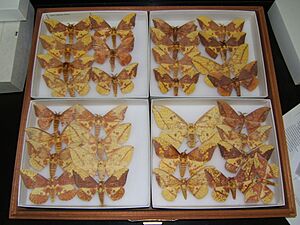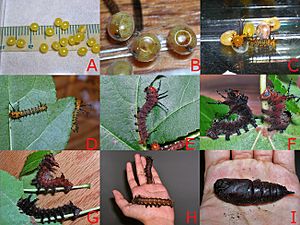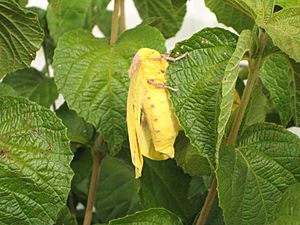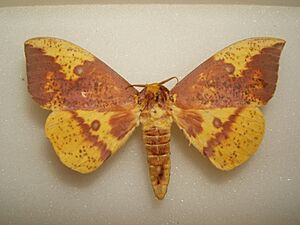Imperial moth facts for kids
Quick facts for kids Imperial moth |
|
|---|---|
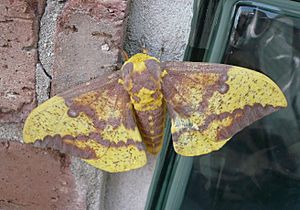 |
|
| Adult male | |
| Scientific classification |
The Eacles imperialis, also known as the imperial moth, is a large, colorful moth found in North and South America. It belongs to a group of moths called Saturniidae, which are known for their big size. This moth was first described by a scientist named Dru Drury in 1773.
Contents
What Does the Imperial Moth Look Like?

Adult imperial moths have a wingspan of about 80 to 175 millimeters (3 to 7 inches). Their colors can vary a lot! They are usually yellow with blotches of red, brown, and purple. Some moths might have fewer dark spots, especially those from northern areas.
Young imperial moths, called larvae or caterpillars, also change a lot as they grow. When they are small, they are orange with black stripes and big spines. As they get bigger, they can grow up to 75 to 100 millimeters (3 to 4 inches) long. They become hairy with shorter spines and can be dark brown, burgundy, or green. Some even have white or yellow patches near their breathing holes.
Where Do Imperial Moths Live?
Imperial moths live in a very wide area, from Argentina in South America all the way up to Canada. You can find them from the Rocky Mountains to the Atlantic Coast. This moth species lives in more places and goes further north than any other moth in its group, Eacles.
The most common type, Eacles imperialis imperialis, used to be found from New England and southern Canada down to the Florida Keys. It even went as far west as Nebraska. Today, you might only find it in places like Martha's Vineyard in Massachusetts. Another type, E. i. pini, lives in pine forests in Canada and the northern Great Lakes States. Other types of imperial moths are found in Mexico and South America.
You can see a map of where E. i. imperialis lives by clicking here.
Different Kinds of Imperial Moths
There are many different types, or subspecies, of the imperial moth. These are like different versions of the same moth that have adapted to live in different places. Here are some of them:
- E. i. imperialis
- E. i. pini
- E. i. cacicus
- E. i. hallawachsae
- E. i. quintanensis
- E. i. decoris
- E. i. tucumana
- E. i. opaca
- E. i. piurensis
- E. i. nobilis
- E. i. magnifica
- E. i. anchicayensis
Why Are Some Imperial Moths Disappearing?
In some parts of the northeastern United States, the number of imperial moths has been going down. Scientists think this might be happening for a few reasons.
- One reason is the use of pesticides and herbicides on farms. These chemicals can harm moths and their food plants.
- Bright street lights can also confuse moths at night.
- Another problem is the introduction of parasitoids. These are tiny insects that were brought in to control other pests, like the gypsy moth. But sometimes, they can also harm imperial moths.
There is a special effort to protect a group of imperial moths on Martha's Vineyard in Massachusetts. They live in a unique oak and pine forest habitat that needs to be preserved. In other areas, like the southern United States, imperial moths are still quite common in forests, rural areas, and even suburbs.
Life Cycle of the Imperial Moth
Imperial moths usually have only one generation each year. The caterpillars, or larvae, of the imperial moth can eat many different kinds of plants. However, what they prefer to eat can depend on where they live. Some of their favorite host plants include pine trees, maple trees, oak trees, sweetgum, and sassafras.
Egg Stage
Female moths lay their eggs at dusk, either one by one or in small groups of 2 to 5 eggs. They place them on the leaves of their host plants. The eggs usually hatch in about ten days to two weeks. When a tiny caterpillar hatches, it often eats its own eggshell for extra nutrients!
Larva (Caterpillar) Stage
The imperial moth caterpillar goes through five different growth stages, called instars. At the end of each stage, the caterpillar sheds its old skin to grow bigger. It attaches itself to a leaf with silk, then becomes still before wiggling out of its old skin. The new skin then hardens. Sometimes, the caterpillar even eats its old skin for protein!
- First Stage: These tiny caterpillars are orange with black stripes. They have two large spines on their front body segments and one large spine near their tail.
- Second Stage: The caterpillars become much darker. Their spines look smaller compared to their body size, and fine hairs start to grow.
- Third Stage: The spines continue to get shorter as the caterpillar grows. The head also becomes darker.
- Fourth Stage: The spines get even shorter, and the hairs on the caterpillar's body become much longer. At this stage, you might start to see different color variations.
- Fifth Stage: These are full-grown caterpillars, about 75 to 100 millimeters (3 to 4 inches) long. They can be dark brown, burgundy, or green. Dark brown ones often have white patches around their breathing holes, while green ones have yellow patches. Some dark brown caterpillars might also have orange patches on their backs and sides. When they finish this stage, they burrow into the soil to change into a pupa.
Pupa Stage
The pupae are dark brown and have small spines on their back end. These spines help them move around in their underground burrow. The pupa's body segments can move a little, but they can't telescope.
Adult Stage
Adult imperial moths have a wingspan of about 80 to 174 millimeters (3 to 7 inches). They emerge from their pupa stage once a year to find a mate. They usually come out at sunrise, and mating happens during the night hours that follow. In northern areas, they tend to emerge in mid-summer (June to August). In southern areas, they can emerge at different times, from April to October. Male moths usually emerge a few days before the females. When a pair of moths is mating, they are more easily caught by predators.
Like all moths in the Saturniidae family, adult imperial moths do not eat. Their mouthparts are very small and cannot be used for feeding. They live off the energy they stored as caterpillars.
Boy vs. Girl Moths
You can tell the difference between male and female imperial moths just by looking at them!
- Male Moths:
* They usually have more blotches of red, brown, and purple on their wings. * Their antennae (feelers) are larger and broader than females'. This helps them smell the special chemicals (pheromones) that females release to attract mates. * Males also have a purple spot on the underside of their ninth body segment.
- Female Moths:
* They are generally larger overall. * Their abdomen (the back part of their body) is bigger because it's full of eggs. * Females are usually more yellow than males. * They have simple, thin antennae.
What Do Imperial Moth Caterpillars Eat?
Imperial moth caterpillars eat leaves from many different kinds of trees and shrubs, including both evergreen (coniferous) and leaf-shedding (deciduous) trees. Here are some examples:
- Pinus (pines)
- Quercus (oaks)
- Acer (maples)
- Liquidambar styraciflua (sweet gum)
- Sassafras albidum (sassafras)
- Eucalyptus
- Acer negundo (box elder)
- Picea abies (Norway spruce)
The E. i. pini type of imperial moth mostly eats pine trees, especially Pinus strobus and Pinus resinosa.
On Martha's Vineyard, the E. i. imperialis caterpillars almost only eat pitch pine (Pinus rigida).
See also
 In Spanish: Polilla imperial para niños
In Spanish: Polilla imperial para niños


